Greenbank Group
Basalt (2020)
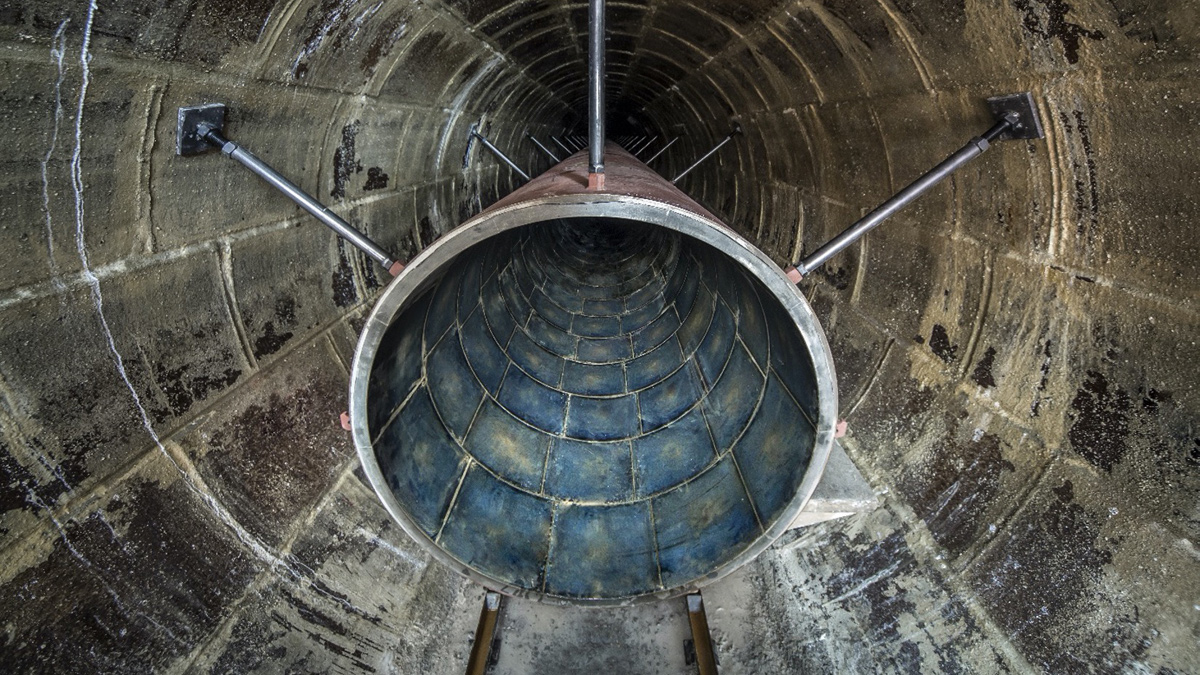
Suspended, basalt-lined pipework beneath the city of Prague - Courtesy of Eutit
A naturally occurring volcanic rock, basalt is one of the toughest natural ceramic materials and can be precast to provide a wide range of products, including tiles, pipe linings and guttering shapes. Up to four times harder than other stone products, basalt is non-porous, highly abrasion and chemical resistant. Melted to 1280°C and cast into steel or sand moulds to produce flat or radial tile shapes to lay as floors, basalt can be retrofitted and installed to protect the bottom sections of existing ovoid or round brick or concrete pipes.
From 50mm up to 3000mm NB basalt is produced as full 360° pipeline systems encased in steel shells for retrofit or new build giving up to 200 years superior life in service. Basalt offers excellent service and high protection from maintenance like jet washing and chemical cleaning to remove blockages caused by waste build up.
As well as proving its value in the wastewater industry, precast basalt is also widely used as a long-lasting lining system in large industrial power and steel, ore and mineral processing plants as well as in the agricultural, dairy, brewery buildings and manufacturing facilities across Europe.
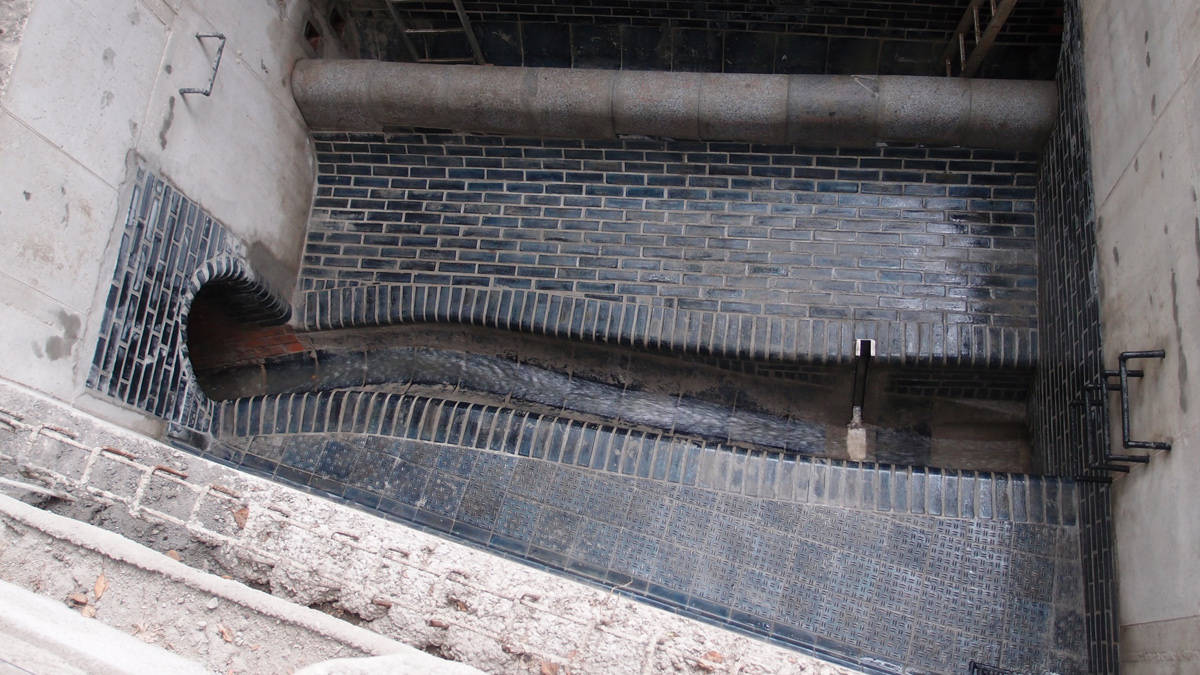
As well as lining sewer channels, basalt is ideal for walkways and other surfaces – Courtesy of Eutit
Case study: Prague ‘A’ Sewer
Constructed between 1895 and 1906, under the supervision of British civil engineer William H. Lindley, Prague’s sewer system came under increasing pressure as the city expanded, particularly in the years that followed the fall of communism in the central European country. The Victorian-era system had served the city well for nearly 100 years but the appearance of sinkholes across the city suggested that significant repair and reconstruction were required, and the city’s floods in 2002 further exposed the inadequacies of the antiquated system that was already prone to voids appearing behind deteriorating brickwork in multiple locations. The city also needed to improve capacity and flow rates to meet the needs of a modern capital city.
Following devastating floods in 2002, a dynamic solution was needed to update Prague’s outdated sewer system to meet the needs of a vibrant 21st century European capital. In the years leading up to the flooding, sinkholes had appeared in several parts of the city in public and residential areas, exposing the frailty of the sewers and the need for a solution designed to future-proof the system. Tried and tested in some of the most demanding heavy industries, locally sourced basalt was identified as having all the qualities required for long-term reliability in the extreme environments found in urban sewer systems.
In the months following the floods, city authorities worked with Greenbank Group’s Czech-based partner Eutit, to fulfil ambitious plans for the renewal and refurbishment of the system, including the ‘A’ sewer that flows directly beneath the historic Old Town Square. Commissioned in 1907, the sewer runs below Pařížská Street and under the river, through an inverted siphon, and then on to a waste-water treatment plant.
Inspections following the floods revealed faults in the system that needed to be rectified immediately, including voids behind the lining which had been caused by the floodwater. Another significant issue exposed by the floods was the considerable wear of the gutter and brickwork that made up the bottom section of the sewer.
While a traditional solution was found for the voids (back-filling with cement or concrete) which proved to be sufficiently load-bearing, a more innovative approach was needed for the bottom of the sewer.
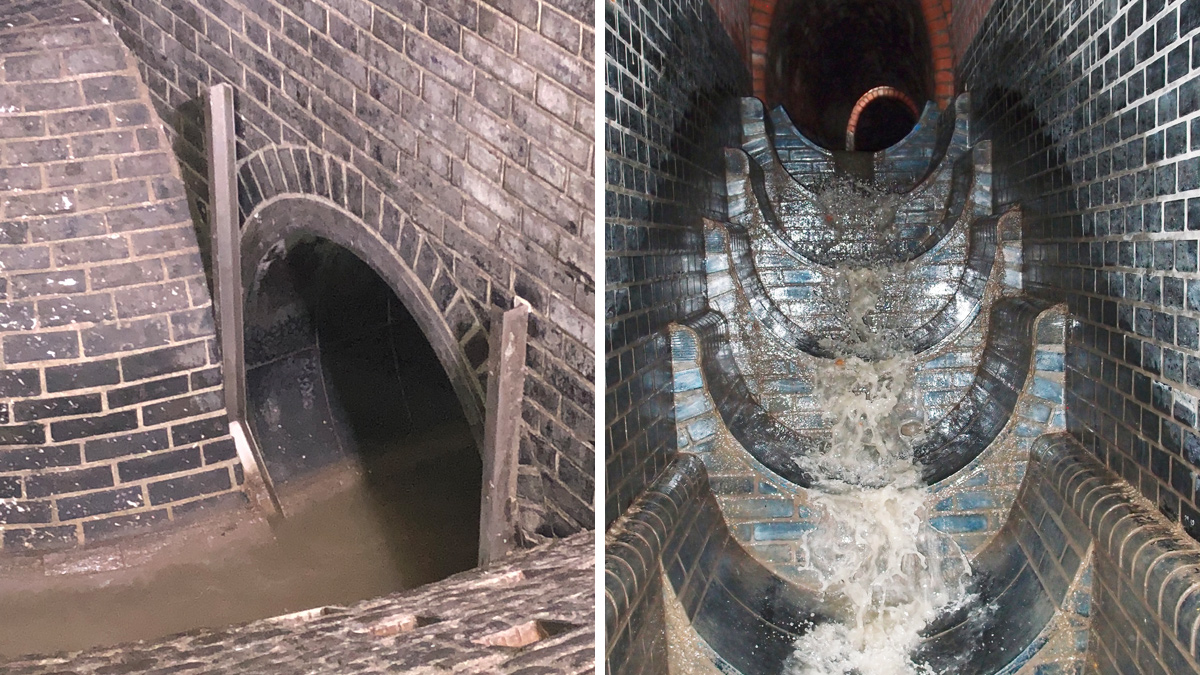
(left) Basalt is ideal for parts of sewer systems that need additional protection and (right) basalt-lined sluice falls beneath the city of Prague – Courtesy of Eutit
Thanks to its excellent durability, chemical resistance and abrasion-resistant properties, cast basalt was selected to repair the bottom of the sewer and sidewalls within the system. While the sidewalls were refurbished by bedding and bonding cast basalt segments over the original brickwork, damaged gutters from the bottom of the sewer were removed and replaced with new cast basalt guttering.
The cast basalt lining system was tied into the structure by installing an L-shaped finishing block, the shorter side of which was fixed and bonded into the milled groove in the existing brickwork. The cast-basalt blocks were then fixed and bonded using a special chemical and water-proofed adhesive compound.
The technical parameters of the project included:
- Length: 608m
- Profile: 1.6m depth/2.4m width
- Gradient: 0.2%
- Sewage flow rate: 250 l/s
- Storm water flow rate: 500 l/s
Case study – Prague Sewer – Trojská Street
The successful utilisation of cast basalt in the repair of the ‘A’ sewer was not the first time the unique material has been used in successful repair of Prague’s sewer system. Engineers also found it proved the ideal solution during another major project some six years earlier following the dramatic collapse of the Trojsky header beneath Trojská Street.
Constructed in phases between 1939 and 1976, the header had been subject to several extensions, although regular maintenance inspections were limited due to access problems. In July 1996, a whole section of the sewer suffered a catastrophic failure, creating large sinkholes and a 10m-long cavern. The collapse was significant due to its wide structural impact with regards to the technical and financial resources required for its repair. Indeed, the total costs associated with the job, including the design and survey works, exceeded CZK 120 million.
Following extensive investigations, the exact cause of the collapse was never conclusively established, but once again the unique properties of cast basalt supplied by Eutit helped to provide a durable, long-term solution to the challenges faced by engineers as part of the extensive sewer restoration project.
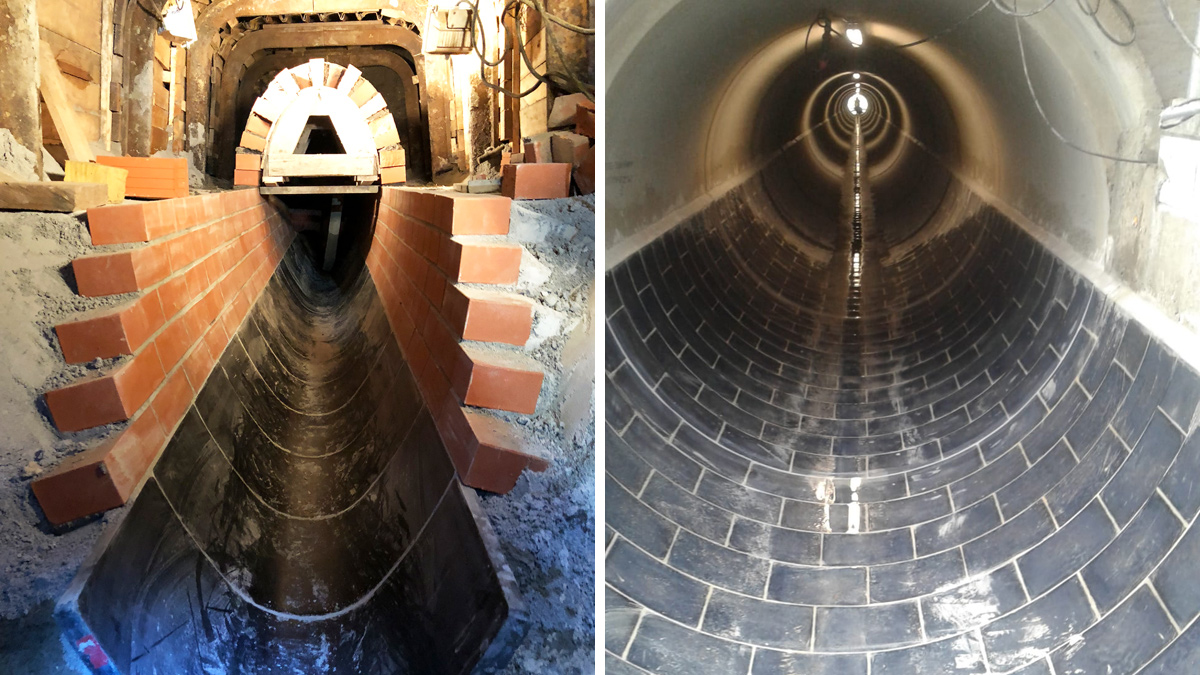
Repaired and restored sections of Prague’s sewer system – Courtesy of Eutit
The engineer responsible recommended four key elements:
- In the extensively damaged sections, and in those sections in which the sewer construction was completely destroyed, the engineer recommended excavating the sewer along its original route. This excavation would be coupled together with the removal of the remaining structure of the header, which would be replaced by a completely new structure. The engineer also proposed installing cast-basalt gutter segments at the bottom and sides of the sewer, along with installing cast-basalt interlocking side panels. Despite basalt being more than suitable for direct adhesion to concrete, it was decided for extra security that the side panels be tied into the surrounding rock with anchor bolts. The remaining part of the structure was designed and built as a traditional brick sewer.
- In the areas in which it was mainly only the bottom part of the header that was damaged, the project engineer proposed the demolition of the entire bottom part of the header. The existing masonry would be underpinned alongside the installation of an entirely new bottom part for the header. This installation would again utilise cast-basalt gutters and side panels.
- The section of the header with the 100/175cm flow profile and the highest gradient between 5 and 9.8% was designed to be renovated by using the sewer-in-sewer technology. This technology consists of lining the existing sewer with cast-basalt gutters and segments that are interlocked across the entire flow profile. The space between the basalt liners and the existing sewer construction was designed to be back-filled with concrete, whilst the roof was filled with shotcrete. Although this technology decreased the flow profile, it was selected due to its hydraulic conveying benefits.
- The upper sections of the header that suffered from either normal wear and tear or minor defects were designed to be repaired in situ. After milling the joints, the brickwork was repointed and the damaged stoneware gutters at the bottom of the sewer were replaced with cast basalt.
Reliable sewers in Prague
Nearly 25 years after the collapse the residents of Prague benefit from one of the world’s most reliable sewer systems thanks to the unique qualities of its revolutionary basalt lining. These qualities include:
- Unrivalled wear, abrasion and chemical resistance.
- Increased flow rates.
- Life expectancy of between 100 and 200 years.
- Provides added protection at junctions and other sections of the system more prone to wear, blockage or failure.
- Resistant to jet washing, unlike PP, PE, PVC, fiberglass, concrete and more traditional building materials.
- Reduced maintenance costs.
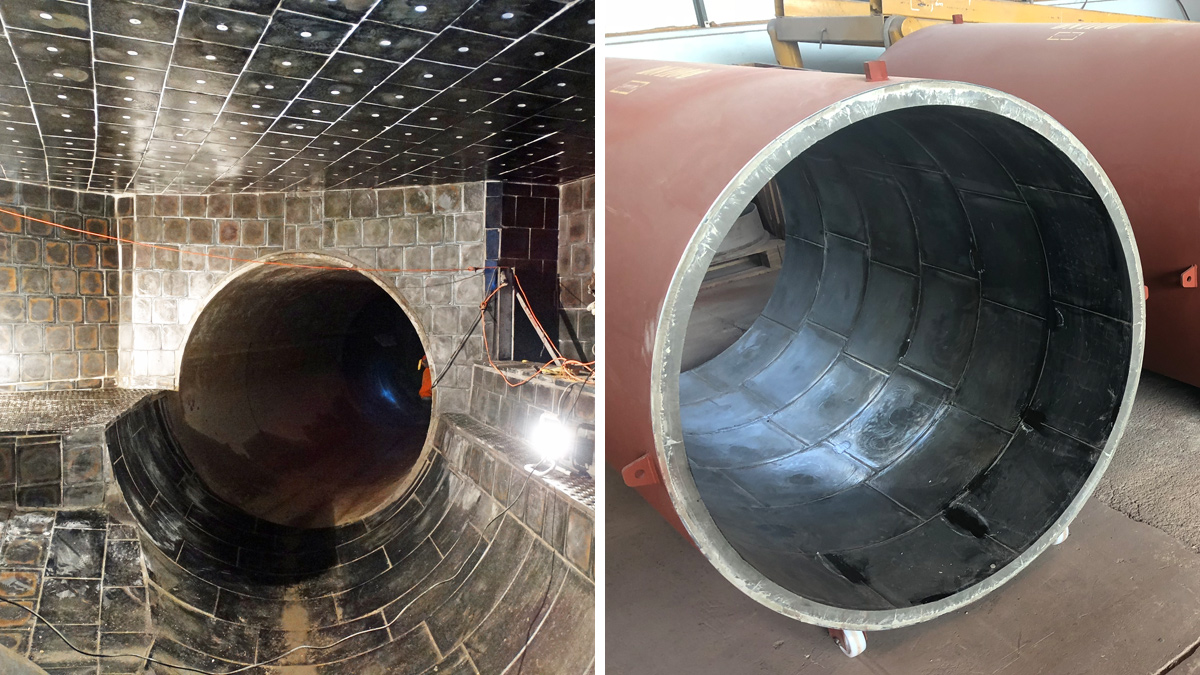
(left) An entire chamber lined in basalt beneath a central European city and (right) basalt-lined pipework – Courtesy of Eutit
Conclusion
In Prague and other central European cities, basalt tiles are already being used to line existing brickwork, a more cost-effective solution than full replacement, and their reduced drag coefficient means improved flow. What’s more, the effective life expectancy of basalt sewer lining systems is estimated at between 100 and 200 years thanks to basalt’s resistance to abrasion and chemicals commonly used in the industry.
Thanks to its partnership with Eutit, Greenbank can now provide a wide range of basalt products for implementation in all sewage disposal systems and drainage projects in the UK. Products now available through Greenbank include bottom gutters, branch pipes and tubes, and slip-resistant elements for walkways, and the company can even supply bespoke-shaped tiles to meet the unique requirements of individual clients.
For more information: Greenbank Group | +44 (0)845 0707 094 | www.greenbankgroup.com








